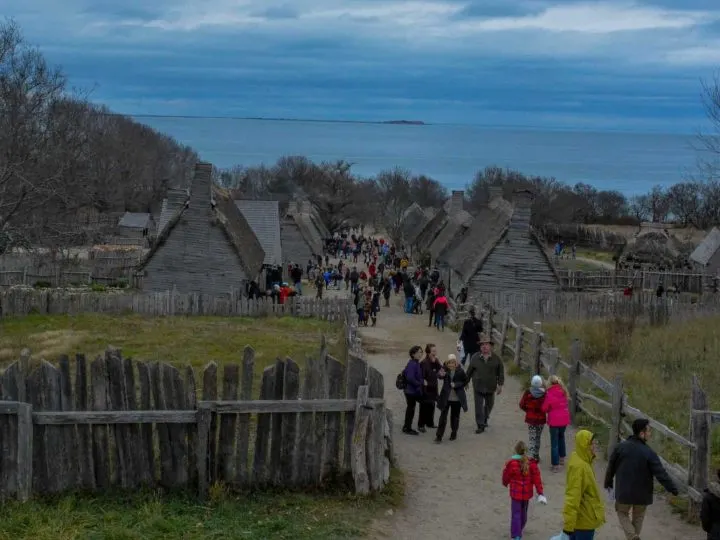Decades ago my great aunt traced my family’s lineage back to the Billington family who sailed across the Atlantic on the Mayflower in 1620. As a child I treasured my great aunt’s visits because she’d tell my sister and I the stories of these American ancestors. As I completed family heritage projects for school, I begged my parents to visit Plimoth Plantation, but seeing as we lived on the California coast, that simply didn’t happen.
Thirty years later, my family is living temporarily on the east coast. As Thanksgiving approached, I discovered that Plimoth Plantation in Plymouth, Massachusetts hosts Thanksgiving dinner, and a couple months in advance snagged some of the last tickets for the Thanksgiving buffet dinner at 6PM. Childhood dreams realized.
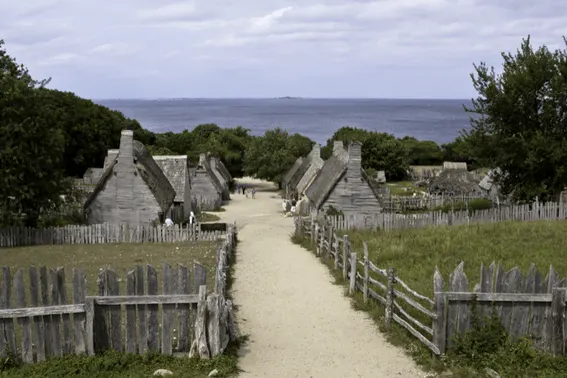
Photo Courtesy of BigStock/the1et
Feeding hundreds of 21st century tourists Thanksgiving dinner is quite an annual production for Plimoth Plantation. However, at the 17th Century English Village and Wampanoag Homesite inside the Plantation, the day goes on just like any other. The villagers cook their meals and do their chores like any November day in 1627 and the Native Americans at the homesite reverently observe and educate about their National Day of Mourning while answering the typical questions about constructing dugout canoes and grinding corn.
Look for current hotel deals nearby Plimoth Plantation
Smell the Food Cooking in the 17th Century English Village
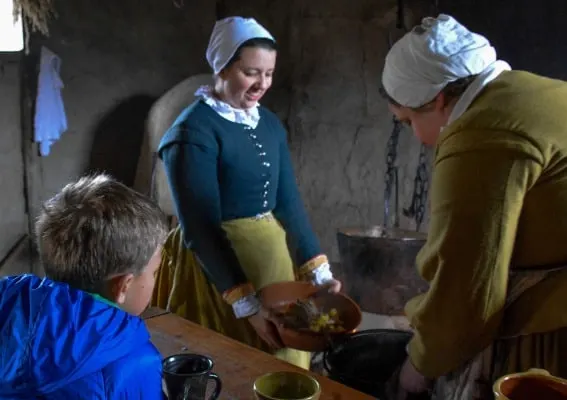
As you might expect, the activities in the recreated 1627 Plimoth village are often dependent on both the day’s weather and what the colonists would have done in that particular season. During our November visit, most of the women were found indoors cooking and the men were outdoors preparing the settlement for the winter or trading with the Native Americans from the homesite nearby.
There are all sorts of living history sites up and down the east coast from Williamsburg in Virginia to the Fortress of Louisbourg in Canada, but Plimoth Plantation differs from the rest in a few fundamental ways. The main feature that sets Plimoth Plantation apart is that each actor onsite plays the part of a person who actually lived in the village in the year of 1627. These actors can tell you about their neighbors, how they arrived in Plimoth, and their daily work; speaking with these actors, visitors can quickly understand how the pilgrim’s fervent religious beliefs colored their perspective on living in America.
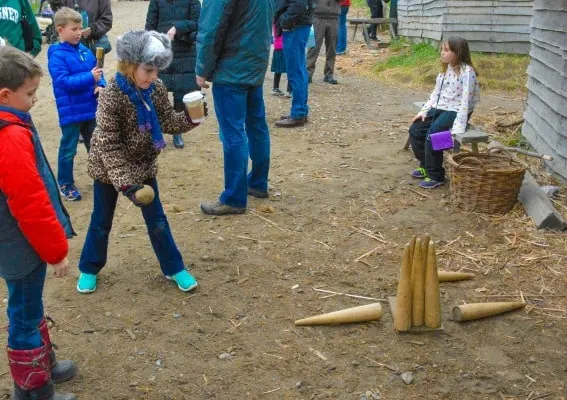
Watching the villagers cook and describe their daily routines was a highlight for our family. My kids will never forget how the settlers made pork sausages using intestines or the smell of the seasoned pork ribs over the fire pit. Like at other sites that we’ve been to, we also watched the blacksmith crafting with metal, observed the settlement’s farm animals, and played colonial games during our visit.
Hear the Traditions at the Wampanoag Homesite
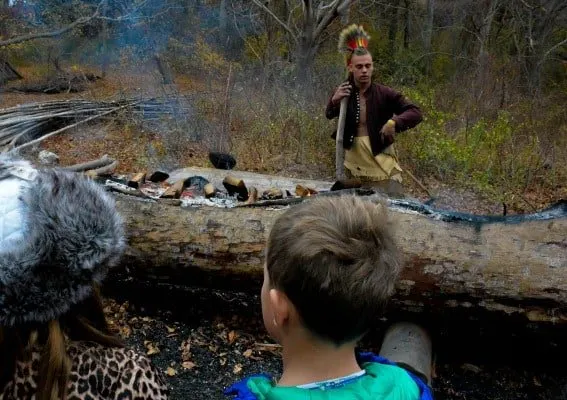
Upon arriving at the Wampanoag Homesite on Thanksgiving, we could immediately tell that this day was just a bit different from any other day. Most of the native Wampanoags were wearing ornate black facial paint; they had applied this paint to signify the National Day of Mourning where the Native American community remembers the darker side of the European’s arrival on American soil. As the children’s story books describe, the interaction of the pilgrim settlers at Plymouth with the local Native People was initially quite friendly primarily due to the fact that the land the pilgrims chose to build upon had been left vacant by disease and plague to the local Wampanoag nation shortly before their arrival. Not long after the traditional, friendly first Thanksgiving in 1621 tensions arose as more business-minded settlers arrived from Europe; these tensions ultimately led to war and a particularly brutal massacre of Native People in this region. It is understandable that the Wampanoag descendants of these people would choose to use this American holiday to remember the story of their ancestors and relate it to the families visiting Plimoth Plantation for Thanksgiving.
In a much different approach from other living history sites, the only people dressed as Native Americans at Plimoth Plantation are people with Native American ancestry who identify with a certain Native American Nation. The local Native People at Plimoth Plantation are generally Wampanoag, though Native People from around America also make an appearance. These people do not act as if they are in the year 1627 while at the Wampanoag Homesite. Instead, they answer questions about their heritage and demonstrate how various things like grinding corn and constructing dugout canoes were done by the local Native People during the time of the Mayflower’s arrival.
My family especially enjoyed watching a dugout canoe being formed by fire during our visit on Thanksgiving Day to the Wampanoag Homesite. The man explaining the technique was wearing traditional costume made by a Native craftsman who was working in the Craft Center up the hill the weekend of our visit. The art of constructing these ornate headdresses with porcupine quills had been handed down to the Native craftsman from his elder family members many years ago.
Check for hotel availability nearby Plimoth Plantation
Watch the Artisans in the Craft Center
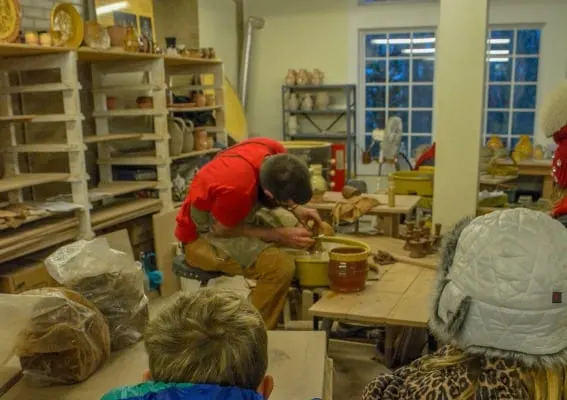
At the top of the hill, steps away from the 17th Century English Village, the Craft Center is located inside a complex with a nice gift shop and restrooms. On a chilly morning, it is one of the best places to warm up at Plimoth Plantation. The artisans at the Craft Center demonstrate various crafts as they would have been done in England during the time period that Plymouth was settled. These crafts include: baking bread, candle dipping, weaving, tailoring, and pottery. The artisans make the clothes, candles, and earthenware that are used on a daily basis inside the 17th Century English Village.
Many living history museums make their own supplies from shoes to pots, but most of them demonstrate this to the visitors outside in the village itself. Since Plymouth relied on craftsmen in England for all of these items and did not have the facilities to make them in America, it is fitting that the Craft Center is housed indoors apart from the village. Also, it’s quite nice that families can enjoy modern heating and air conditioning while observing the craftsmen at work; my kids spent at least a half hour simply watching the potter make candlesticks during our visit.
Walk the Town of Plymouth and Visit the Grist Mill

Honestly, I was completely prepared to skip the town of Plymouth, a 10-15 minute drive from Plimoth Plantation. Who needs to see a rock with questionable historic significance anyway? However, I was wrong; the town of Plymouth is charming, and worth visiting even if you couldn’t care less about Plymouth Rock. There are towering statues and memorial plaques commemorating the various players in this early 17th century American story and a cute little park with a trail that leads up to the Grist Mill.

The Grist Mill is tiny, and I imagine it can easily get crowded in peak season. However, it was really a highlight for my children. Upstairs families can see the grindstone, which the site actually operates during scheduled times throughout the week, and hear about the corn that would have been ground in America and England in the 17th century. Downstairs are a few hands-on science exhibits that demonstrate how the mill works and how the ground corn is processed. This small hidden gem is included in some Plimoth Plantation ticket prices.
Eat Your Thanksgiving Dinner at Plimoth Plantation

If you ask the pilgrims in the 17th Century English Village about Thanksgiving, they won’t tell you anything about the holiday that the modern United States celebrates every November. Possibly they will tell you a bit about how they are thankful that God provides or how they prepare for the winter months at this time of year. However, the fact that Thanksgiving isn’t celebrated in the village, does not mean that Thanksgiving is not celebrated at the plantation.
Plimoth Plantation offers a few options for Thanksgiving dinner, a buffet option and a sit-down dinner option both of which must be reserved in advance as well as an a la carte option in a small tent outside the visitor center. More or less the food offerings at all of these meals are similar, though it appears that the sit-down dinner might have a few extras, which makes sense because it is the most expensive. The food served at the buffet and the outdoor tent appeared very similar based on my cursory look.
My family ate at the 6PM buffet on Thanksgiving Day. We were served apple cider or water based on our preferences and there was a cash bar available. The first course was a small salad and soup which had a separate line from the main course. The main course included: turkey served with both white and dark meat and stuffing, beef roast cooked quite rare, mashed potatoes, squash, carrots, cornbread, and rolls. We walked through the line and only asked to be served the dishes which we wanted to eat. I was totally satisfied, and I never had to touch the mashed potatoes, the traditional Thanksgiving dish that I prefer to avoid. Of course, apple or pumpkin pie was available to finish off the meal!
Look for the best hotel prices nearby Plimoth Plantation
Know Before You Go – Thanksgiving Weekend in Plymouth, Massachusetts
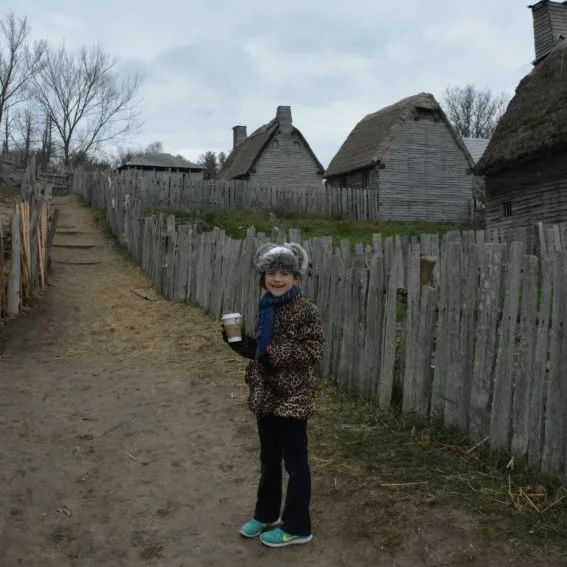
- We heard that there are peaceful demonstrations and protests in the town of Plymouth by Plymouth Rock on Thanksgiving Day in honor of the National Day of Mourning. If you plan on being in the town of Plymouth (not the plantation) on Thanksgiving Day, be prepared for this. We visited the town of Plymouth the morning after Thanksgiving before heading back to Plimoth Plantation, and there were only a few other families in town at that time.
- The staff at Plimoth Plantation manage the Thanksgiving crowds with ease. They have it completely figured out and are more than prepared for the big day. Even though we were totally clueless as to what was happening, the staff got us where we needed to be when we needed to be there. They were welcoming, helpful, friendly, and made the experience a memorable holiday that we will never forget.
- If you plan on eating at Plimoth Plantation on Thanksgiving Day plan to reserve your tickets at least a couple of months in advance. The non-reserved a la carte options are not quite up to par. For dinner people dress up slightly with little girls in dresses, women in slacks and men in collared shirts – though I wouldn’t have felt too out of place at the buffet had we not chosen to dress for the occasion.
- If you have reserved buffet dinner, we found that they began seating parties before the time designated on our ticket. It does not really matter when you arrive as seating is assigned. But, if you’re hungry, it doesn’t hurt to arrive a bit early. We were seated with a family whose children where approximately the same ages as our own.
- We drove all the way from Hershey, Pennsylvania on Thanksgiving Day and had very little traffic until reaching two-lane highways in Massachusetts. (However, driving back through Connecticut on Saturday afternoon was a different story…)
- We stayed at the Hilton Garden Inn in Plymouth. It is the closest chain hotel to Plimoth Plantation. Here is my complete review of Hilton Garden Inn Plymouth.
- Yes, there are crowds. However, these crowds were in no way a hassle. There was plenty of room for everyone.
All photos by Melissa Moore unless credited otherwise.

